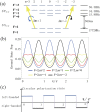Improving sodium laser guide star brightness by polarization switching
- PMID: 26797503
- PMCID: PMC4750368
- DOI: 10.1038/srep19859
Improving sodium laser guide star brightness by polarization switching
Abstract
Optical pumping with circularly polarized light has been used to enhance the brightness of sodium laser guide star. But the benefit is reduced substantially due to the precession of sodium atoms in geomagnetic field. Switching the laser between left and right circular polarization at the Larmor frequency is proposed to improve the return. With ESO's laser guide star system at Paranal as example, numerical simulation shows that the return flux is increased when the angle between geomagnetic field and laser beam is larger than 60°, as much as 50% at 90°. The proposal is significant since most astronomical observation is at angle between 60° and 90° and it only requires a minor addition to the delivery optics of present laser system.
Figures





References
-
- Norvig P. et al.. 2020 visions. Nature 463, 26–32 (2010). - PubMed
-
- Cunningham C. Future optical technologies for telescopes. Nat. Photon. 3, 239–241 (2009).
-
- Meyer L. et al.. The shortest-known-period star orbiting our Galaxy’s supermassive black hole. Science 338, 84–87 (2012). - PubMed
-
- Babcock H. W. The possibility of compensating astronomical seeing. Publ. Astron. Soc. Pac. 65, 229–236 (1953).
-
- Ageorges N. & Dainty C. Laser Guide Star Adaptive Optics for Astronomy. Ch. 4, 67–87, (Springer: Netherlands, 2000).
LinkOut - more resources
Full Text Sources
Other Literature Sources

